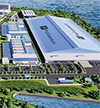Incentives for Advanced Manufacturing: Out of Step with the Times
Advanced manufacturing, which requires fewer workers than low-tech operations, often cannot take advantage of incentives tied to large job-creation requirements.
Q4 2015

Have state governments that use tax breaks and other inducements to attract industrial projects updated their incentives to reflect these changing times? Conversations with site selection consultants and state officials paint a varied picture.
A Decline in Number of Jobs Per Project
While “high-labor content projects are still coming to the U.S., there is an advanced manufacturing meta-trend: replacing man-hours with kilowatt-hours,” says Darin Buelow, a principal with Deloitte Consulting. “Machines are doing more work, and the average number of jobs per project has been going down for some time.”
One example of the modern metrics: Monogram Food Solutions, a major manufacturer of meat snacks, is expanding its business into the city of Schulenburg, Texas. The new plant will only employ 30 workers, but involves a total capital investment of nearly $3 million. The city of Schulenburg was awarded $750,000 from the Texas Capital Fund (TCF) to finance infrastructure upgrades to support the new facility.
While high-labor content projects are still coming to the U.S., there is an advanced manufacturing meta-trend: replacing man-hours with kilowatt-hours...Machines are doing more work, and the average number of jobs per project has been going down for some time. Darin Buelow, Principal, Deloitte Consulting
Buelow says he has long contended that state incentives “have not kept pace with the times; for example, tax incentives that don’t kick in until 300 jobs have been created. If you’ve got $100 million capital investment but only create 100 jobs, you don’t qualify. Some states see proposals for (projects creating) 100 or 150 jobs all day long, but can’t use that program.”
Buelow believes there should be a more flexible posture when it comes to manufacturing. “Incentives need to be more accessible by advanced manufacturers,” he explains.
Jeff Forsythe, a principal with Greenville, S.C.-based McCallum Sweeney Consulting, notes that different locations often have different priorities when using incentives such as tax breaks. “Some locations…where unemployment is a major concern…are more in interested in jobs. More urban areas that have full employment — less than 4 percent unemployed — are just trying to enhance the tax base and don’t mind highly automated facilities that involve high capital investment.”
Although they employ relatively few people, large industrial projects (especially data centers) that are capital-intensive and consume large amounts of electricity can often qualify for additional incentives offered by utilities — particularly in the southeastern U.S., Forsythe says. In addition to rate reductions, some utilities are also putting cash in land and infrastructure to incentivize projects.
Ironically, Buelow notes, state incentives often seem to “be countercyclical to the broader economic cycle. When we’re in a recession, projects dry up and more states are wondering ‘What’s wrong with us? Why aren’t we seeing more activity? We need to retool.’” On the other hand, he says, “When the economy is rocking and rolling, legislatures seem to be inclined to remove available incentives. They may think, ‘Times are good, companies are talking to us; we don’t need some of these things.’ So, we seem to go back and forth between extremes.”
Getting More Creative
Economic development competition among states has intensified over the years, and many companies that tap into incentives have been doing so for decades. As a result, states are being asked to get more creative, and think about other ways to help businesses, beyond tax breaks, cash grants, and low-interest loans.
“There is this ‘frontier of creativity.’ Some states are quite adept at offering different modes of assistance, some that are a little nontraditional,” Buelow says. Often, these creative ideas don’t cost taxpayers — so-called “soft assistance,” Buelow explains, such as adding a job-creating newcomer to state bid lists.
One state that has updated its (incentives) programs is North Dakota. To stay competitive, and help its resident companies stay competitive, in 2013 the state created an “automation credit.”
Buelow also sees more states offering custom training tailored to the specific needs of a company “rather than offering something on shelf that has to be delivered by the state training authority.” While some states that formerly lagged behind have developed “best in breed” training programs, such as Georgia’s Quick Start program and Louisiana FastStart, others have been reluctant to do that, Buelow says. One useful strategy is allowing state economic development funds to be used “to pay workers’ salaries, while they are being trained. Companies want flexibility, customization, and fungibility,” he notes.
Josh Bays, a principal with the Dallas-based Site Selection Group, agrees that not all states have kept pace with changing industrial times. “Historically, economic incentives have rewarded job creation more than capital investment. Intuitively, you would think that those states and communities that want to be more aggressive would start rewarding capital investment more than they have in the past. But a lot of state-level incentives are still based more on job creation.”
One state that has updated its programs is North Dakota. To stay competitive, and help its resident companies stay competitive, in 2013 the state created an “automation credit,” according to Laura Willard, a project manager for the North Dakota Department of Commerce’s Economic Development and Finance division. The credit, designated for the tax years 2013 through 2015, provides an income tax credit equal to 20 percent of the cost of automation equipment. The state is in the process of evaluating “all of our tax incentives,” Willard notes.
Evaluating the Effectiveness of Incentives Programs
Several years ago, The Pew Charitable Trusts developed a “business incentives initiative” to help states identify and share best practices for collecting, managing, and analyzing data on economic development incentives. Pew funded research to evaluate the effectiveness of states’ economic development initiatives. Pew concluded “lawmakers often approve or continue incentives without knowing their potential cost or whether they are working,” and cited a “knowledge gap.”
Historically, economic incentives have rewarded job creation more than capital investment. Intuitively, you would think that those states and communities that want to be more aggressive would start rewarding capital investment more than they have in the past. But a lot of state-level incentives are still based more on job creation. Josh Bays, Principal, Site Selection Group
According to Pew, from 2012 to 2014, 10 states and the District of Columbia passed laws that will require regular evaluation of tax incentives or will improve existing evaluation processes. Maine, Minnesota, Nebraska, North Dakota, Oklahoma, Tennessee, and Texas enacted laws requiring regular evaluation of tax incentives in 2015.
Jason Hickey, president of Hickey & Associates, LLC, says that although jobs are “still the critical factor” in most states, some have allowed capital investment to be the qualifying inducement to capture incentives, citing Alabama as one example. Earlier this year, the state of Alabama adopted a new incentives platform that, for the first time, included an incentive specifically tied to job creation. However, the job-creation target to qualify for incentives is relatively low — 50 jobs. In order to stimulate investment in rural areas, Alabama has lowered the number to 25 jobs for projects in counties with populations below 25,000, according to Alabama’s Commerce Secretary Greg Canfield.
Hickey says companies often sign up for incentives that have very little value to them — such as incentives based on tax revenue levels “they would never be able to achieve. It’s not up to the state to decide what is valuable; it’s up to the company,” he notes. Almost half of all incentives available are never realized by companies because they don’t meet the requirements. For companies that accept incentives, it’s also important to have an “aftercare process in place so they can make sure they live up to the expectations they agreed to,” Hickey says.
Bays says companies sometimes fail to consider key “operational factors. Incentives are awarded for finite periods of time — most often between one and 10 years. Most companies have plans to be operational in a location much longer than that.” And, it’s still the case that economic incentives rank lower on location-decision lists than workforce considerations, regulatory hurdles, and infrastructure factors.
Bays sees a trend of states becoming “more stringent on the compliance side. They’re requiring a more lengthy compliance process and more stringent clawback policies, making sure they are holding companies accountable.” On a final note, he advises companies to “make sure you really understand what portion of an incentive package is actually useable by your company, and also carefully evaluate compliance requirements.”
Project Announcements
Hims & Hers Health Expands New Albany, Ohio, Operations
12/28/2025
Poly6 Technologies Expands Eastlake, Ohio, Operations
12/26/2025
Ohio Lumex Expands Solon, Ohio, Operations
12/26/2025
Calgon Carbon Corporation Expands Pittsburgh, Pennsylvania, Operations
12/25/2025
Cascades Expands Eau Claire, Wisconsin, Operations
12/25/2025
P.C. Campana Plans Vicksburg, Mississippi, Production Operations
12/25/2025
Most Read
-
The Workforce Bottleneck in America’s Manufacturing Revival
Q4 2025
-
Rethinking Local Governments Through Consolidation and Choice
Q3 2025
-
Lead with Facts, Land the Deal
Q3 2025
-
Tariff Shockwaves Hit the Industrial Sector
Q4 2025
-
Investors Seek Shelter in Food-Focused Real Estate
Q3 2025
-
America’s Aerospace Reboot
Q3 2025
-
The Permit Puzzle and the Path to Groundbreaking
Q3 2025


